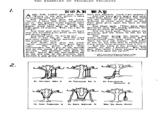Tree Swing Cartoon Parodies

About
The Tree Swing Cartoon Parodies, also known as "What The Customer Really Needed" (Japanese: 顧客が本当に必要だったもの), are a series of multi-pane, exploitable webcomics based on a satirical cartoon about building a tree swing through division of labor in corporate environment. Since its first appearance in the early 2000s, the cartoon has inspired dozens of parodies poking fun at various failures in product development and the culture of corporate bureaucracy in general, in similar vein to All Right Gentlemen and Corporate Logic.
Origin
The original cartoon made its first online appearance on September 9th, 2003 in an English-language blog post titled "Typical Project Life,"[1] which metaphorically explains various perception gaps that often arise in software development projects through the simple task of building a tree swing. In the following year, a Japanese translated version of the cartoon titled "This is How IT Projects Really Work" was posted via Dashi Blog on February 22nd, 2004.[2]

Precursors
The "tree swing" cartoon has been used to explain or satirize perceived discrepancies in IT project management as early as the 1970s, with its earliest known iteration published in the March 1973 issue of University of London Computer Center Newsletter (shown below, left). In 1975, the same illustration (shown below, right) was cited in the book The Oregon Experiment[3] written by Christopher Alexander[4], an architect known as the founder of "Pattern Language". More information about the pre-Internet history of "tree swing" cartoons can be found on the career advice blog BusinessBalls.[5]


Spread
Between 2004 and 2006, the cartoon continued to spread across the international blogosphere, eventually leading to the launch of The Project Cartoon, a website dedicated to curating parodies and translated variations of the original cartoon, in 2006.[6] Meanwhile on the Japanese web, the cartoon gained much recognition under the name "What The Customer Really Needed" (dubbed after the caption from the last panel) and began appearing on imageboard communities like Futaba Channel (2chan), including a compilation of parody instances uploaded in July 2008.[7] In addition, an article for the "Tree Swing" cartoon was submitted to Nico Nico Douga's encyclopedia in September 2010.[8]
Notable Examples









Search Interest
External References
[1] WEBLOG.CEMPER.COM – Typical Project Life / Posted on 09-09-2003 (Internet Archive)
[2] Dashi Blog – ITプロジェクトの実態とは! / Posted on 02-22-2004 (Japanese, Internet Archive)
[3] Wikipedia – The Oregon Experiment
[4] Wikipedia – Christopher Alexander
[5] businessballs.com – tree swing pictures – tire swing, tire swing, rope swing cartoon pictures
[7] バカ集合 – 顧客が本当に必要だったもの (Japanese)
[8] niconico Pedia – 顧客が本当に必要だったもの (Japanese)
Recent Videos
There are no videos currently available.







Top Comments
Crimson Locks
Jan 09, 2013 at 07:39PM EST
Rukario
Jan 09, 2013 at 06:28PM EST